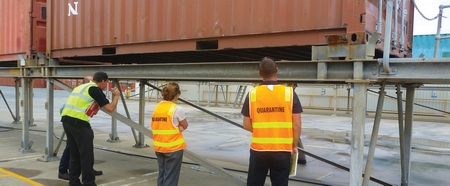Containing the spread of hitchhiking pests

The past 50 or so years has seen a dramatic change in the volume, and mode, of international trade. Not only has the volume escalated substantially, but around 90% of it is carried by sea, mostly in containers.
This is clearly illustrated by the myriad of sentry-like gantry cranes that punctuate the skyline over most major trading ports. The regimented blocks of stacked sea containers that they service amount to a staggering worldwide total port throughput per year of some 300 million containers.
The downside to this unprecedented level of global trade is the transport of unwanted contaminants and ‘hitchhiker’ pests that are inadvertently transported on, or in, the containers, irrespective of the cargo. Thousands of exotic species have become established in new environments – about 1700 known insect and 2400 plant species in New Zealand alone. Not all are damaging, but some have the potential to cause enormous environmental and economic impacts. This increase in biological invasions has been clearly linked to the growth in international trade.
Principal Scientist Dr Eckehard (Ecki) Brockerhoff says that inspection records from the United States, Australia, China and New Zealand indicate that thousands of organisms from a wide range of taxa are being moved unintentionally with sea containers.
He says, “Inspection records of 116,701 empty sea containers arriving in New Zealand between 2010 and 2015 showed that around 10% of them were contaminated on the outside, and 5% on the inside. This level was even higher in other countries.”
Some of the better-known hitchhikers were gypsy moth, giant African snail, Argentine ant and brown marmorated stink bug - pests that seriously threaten forests, agriculture and urban environments, and cause substantial economic and environmental damage in many countries. Soil residues were also found, and these often contained seeds of invasive plants, nematodes and plant pathogens.
In 2006, the Ministry for Primary Industries implemented a hygiene system for sea containers coming into New Zealand from several Pacific Island countries that, according to MPI, has since reduced the contamination rate of containers from those countries by 90%. This involves inspection, cleaning, verification, training and prevention of contamination. Prior to this, every second empty container arriving in New Zealand from these origins were contaminated.
Ecki has been working with MPI and the Better Border Biosecurity Collaboration to advance the development of an International Standard for Phytosanitary Measures (ISPM) to reduce the incidence of hitchhiking pests on sea containers worldwide. Ecki was invited to present a paper on this work to the Commission on Phytosanitary Measures (CPM), the governing body of the International Plant Protection Convention (IPPC), when it met in Rome in May. The IPPC is responsible for setting phytosanitary standards for international trade in plants and plant products.
“Our research shows there are considerable risks associated with sea containers moving pests and other contaminants around the world, and that an international phytosanitary standard for sea containers is likely to reduce pest arrivals and establishments substantially,” says Ecki. “It will also provide economic net benefits as a result of avoided damages caused by invasive species and other contaminants being transported
with sea containers.
“This would be a huge benefit to border biosecurity, as well as reducing compliance costs for shipping companies, exporters and importers both in New Zealand and worldwide.”
While the CPM delegates made thedecision to take more time to develop an ISPM, they agreed the risks warranted action. In the meantime the effectiveness of voluntary measures will be explored, and the ISPM will be revisited in five years.
Director for Plants, Food & Environment at MPI, Peter Thomson says, “While the risk from sea container contamination is obvious to New Zealand, many countries either don’t understand the risk, or believe it’s just too hard to manage. Having Dr Brockerhoff present his findings to the 182 member countries of the IPPC was instrumental in gaining sufficient support to continue the work to better manage this risk at an international level.”
